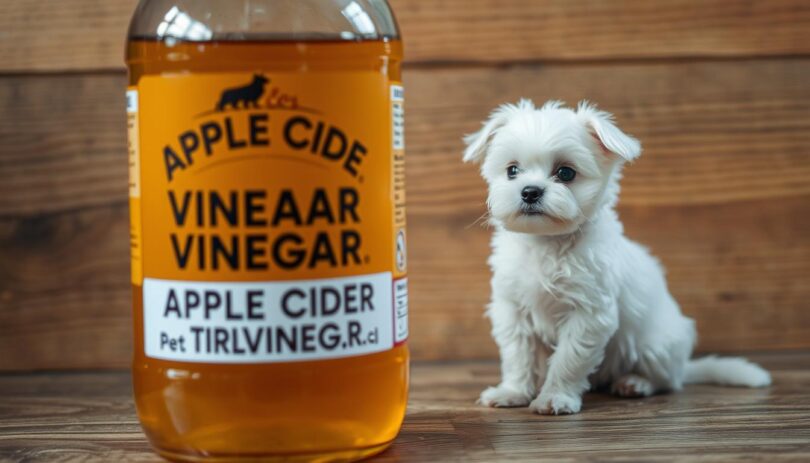Every pet owner knows the frustration of spotting a flea scurrying through their dog’s fur or cat’s favorite napping spot. Natural solutions often feel like a safer first step compared to harsh chemicals. Among these options, one household staple sparks curiosity: can a simple pantry item truly make a difference?
Raw, unfiltered apple cider vinegar has been used for centuries in human health and home care. Its sharp aroma and acidic properties have earned it a reputation for repelling pests. But when it comes to flea management, the line between myth and reality often blurs. While it may not eliminate infestations outright, many find it helpful as part of a broader strategy.
Understanding how natural remedies work is key. Apple cider vinegar alters the pH balance of a pet’s skin, creating an environment fleas avoid. This distinction between repelling and killing pests matters for setting realistic expectations. Safe application methods are equally critical, especially for animals with sensitive skin.
This guide explores the science behind using vinegar in pet care, practical tips for integrating it into routines, and how to pair it with other treatments. By balancing tradition with modern insights, pet owners can make informed choices tailored to their furry companions’ needs.
Understanding Flea Infestations and Natural Solutions
Fleas pose more than a temporary annoyance—they threaten your pet’s comfort and household hygiene. These wingless parasites survive by feeding on blood, multiplying rapidly to create persistent problems. Recognizing their behavior and early warning signs helps prevent full-blown invasions.
What Are Fleas and How Do They Affect Pets?
Adult fleas measure 1–3 millimeters and thrive in warm environments. Their life cycle spans four stages: egg, larva, pupa, and adult. A single female lays up to 50 eggs daily, which drop into carpets or bedding. These pests cause itching, hair loss, and allergic reactions in dogs and cats. Severe infestations may lead to anemia, especially in young animals.
Recognizing the Signs of a Flea Infestation
Excessive scratching often signals trouble. Check for tiny black specks (flea dirt) or white oval eggs in your pet’s fur. Red bumps or scabs around the neck and tail areas are common. Homes with infestations may show “salt and pepper” debris in pet resting spots. Flea bites on humans typically appear as clustered red marks on ankles.
Ignoring these signs risks rapid spread. Flea eggs hatch within days, and larvae hide in fabrics. For effective flea control strategies, early intervention is critical. Addressing both pets and their environment breaks the reproduction cycle before it escalates.
How to Use Apple Cider Vinegar in Flea Treatment
Natural remedies offer a gentle approach to managing pests on pets, and apple cider vinegar stands out for its accessibility. When prepared correctly, it can help repel unwanted visitors without harsh side effects. Let’s explore how to create and apply a safe mixture tailored for dogs and cats.
Preparing the Apple Cider Vinegar Solution
Start by mixing equal parts raw, unfiltered apple cider vinegar and water. For sensitive skin, use a 1:2 ratio (one part vinegar to two parts water). Always test the solution on a small patch of fur first. Wait 24 hours to check for redness or irritation before full application.
Application Methods for Dogs and Cats
Pour the mixture into a spray bottle for easy use. Lightly mist your pet’s coat, avoiding eyes and open scratches. Alternatively, dip a grooming brush into the solution and comb through their fur. This spreads the liquid evenly while removing loose debris.
Reapply every 2–3 days for consistent results. Pair this routine with regular vacuuming and washing pet bedding to get rid of fleas effectively. Remember, the goal is to create an unwelcoming environment for pests—not eliminate them instantly. Adjust ratios if your pet shows discomfort, and consult a vet for severe infestations.
Does Vinegar Kill Fleas: Myths vs Facts
The debate over natural flea solutions often centers on household staples like vinegar, but separating fact from fiction is crucial. While many claim it eradicates infestations, research tells a different story.
Examining the Scientific Perspective on Vinegar’s Effectiveness
Studies from institutions like the University of California confirm vinegar’s acidity may repel adult fleas but doesn’t eliminate eggs or larvae. Its acetic acid content disrupts pests’ sensory cues, making treated fur less appealing. However, no peer-reviewed trials prove it destroys these parasites outright.
Comparing Vinegar with Conventional Flea Medications
Prescription treatments target all life stages—adults, eggs, and larvae—breaking reproduction cycles. For example, fipronil-based products kill 95–100% of adult fleas within 24 hours in controlled studies. In contrast, natural remedies like diluted vinegar primarily offer temporary repellent effects.
Pet owners should note potential skin irritation from acidic solutions. Always dilute mixtures and monitor for redness. While phrases like “kill fleas” dominate searches, understanding their limitations prevents disappointment. Combining gentle repellents with proven methods balances safety and results.
Integrating Vinegar with Other Home Flea Control Methods
A successful flea management plan requires multiple layers of defense. Pairing natural solutions with thorough cleaning creates an environment where pests struggle to survive. Let’s explore how to amplify results by combining methods.
Enhancing Treatments with Natural Allies
Diatomaceous earth works well alongside diluted solutions. This powder dehydrates flea eggs when sprinkled on carpets. For pets, mix a teaspoon of food-grade diatomaceous earth into their shampoo during baths. Salt also helps—sprinkle it on furniture and carpets overnight to dry out larvae.
Essential oils like lavender offer extra repellent power. Add two drops to your spray bottle mixture for dogs over 12 weeks old. Always avoid citrus oils for cats, as they can be toxic. These additions boost your strategy without harsh chemicals.
Cleaning Strategies for Lasting Results
Wash pet bedding weekly in hot water above 130°F to get rid of eggs. Vacuum floors and upholstery daily, focusing on baseboards and crevices. Empty the vacuum immediately into a sealed bag to control escaping pests.
For stubborn areas, apply salt before vacuuming. The abrasive texture disrupts flea life cycles. Rotate between cleaning agents—use vinegar solutions one week and soapy water the next. This variety prevents pests from adapting.
Consistency transforms individual actions into a system. Pairing natural treatments with mechanical removal tackles infestations at every stage. Always consult pest control experts when designing your multi-step approach.
Wrapping Up Your Flea Treatment Journey
Effective flea control combines timely detection with strategic methods. While natural solutions like diluted apple cider vinegar may repel pests, they rarely eliminate infestations alone. Early signs—scratching, flea dirt, or irritated skin—demand quick action to protect your pet’s health and home hygiene.
Preparing safe mixtures requires careful dilution and skin tests. Pairing these with conventional medications tackles both adult fleas and resilient larvae. Integrated approaches yield better results: vacuum daily, wash bedding weekly, and use pet-safe powders in problem areas.
Persistent issues often stem from hidden eggs in carpets or upholstery. Focus on disrupting the flea life cycle by targeting larvae before they mature. For cats and dogs with sensitive skin, consult your vet to balance natural remedies with clinical treatments.
Stay proactive. Monitor your pet’s behavior and environment, adjusting strategies as needed. When home methods fall short, professional guidance ensures your companion’s well-being. With patience and layered efforts, you’ll create a safer space for your furry family members.
FAQ
Can apple cider vinegar eliminate flea infestations on pets?
While apple cider vinegar may repel adult fleas due to its acidic properties, it doesn’t fully eradicate infestations. It’s less effective against eggs and larvae, so pairing it with other methods like thorough cleaning or vet-recommended treatments improves results.
How do I safely apply apple cider vinegar to my dog or cat?
Mix equal parts raw apple cider vinegar and water in a spray bottle. Lightly mist your pet’s fur, avoiding eyes and open wounds. For sensitive animals, dilute the solution further or apply it to a brush before grooming. Always test a small area first.
Is vinegar a reliable alternative to prescription flea medications?
No. Commercial flea treatments are scientifically formulated to target all life stages of fleas, including eggs. Apple cider vinegar works best as a supplementary preventive measure or mild repellent, not a standalone solution for severe infestations.










Leave a Comment